With the allure of breathtaking landscapes and the promise of a rejuvenating escape into nature, hiking offers an unparalleled opportunity to explore the great outdoors. Yet, every step along the winding trails and steep ascents carries a risk of hiking injuries—blisters, muscle pain, and sudden fatigue, to name a few. These are not just minor inconveniences but potential setbacks that could derail your adventurous spirit. Whether you’re tackling a short day hike or preparing for a multi-day trek, understanding these risks and knowing how to respond can make all the difference. Join us as we unfold the layers of expert advice and shared experiences to help you keep your hiking adventures safe and enjoyable.
First aid for hikers
Blisters, muscle pain, sudden fatigue, sore feet, red spots on the lower legs, and swollen fingers—every hiker deals with these issues at some point. But how can you prevent and treat these common hiking injuries and ailments? During a “Walk & Talk” on Saturday, August 24th, pilgrim and general practitioner Judith van den Hoven provided answers to these questions. Judith hiked over 700 kilometers on the Camino Francés and has been a GP in The Hague for 12.5 years.
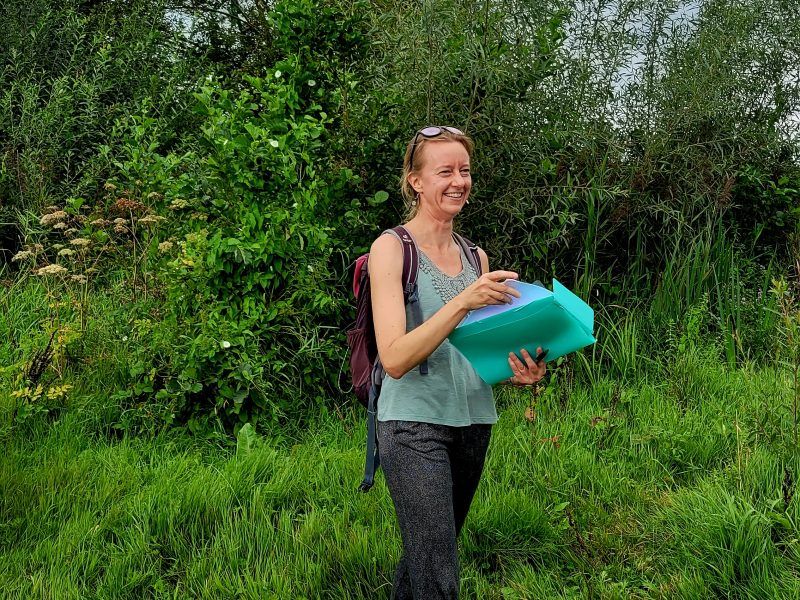
We started our walk from Geldrop station and covered 17 km to Heeze station. Following the Kleine Dommel river, we entered a beautiful natural area. The stream valley of the Kleine Dommel gradually transitions into the Strabrechtse Heide, also known as the “Great Silent Heath.” Towards the end, the route took us past Heeze Castle.
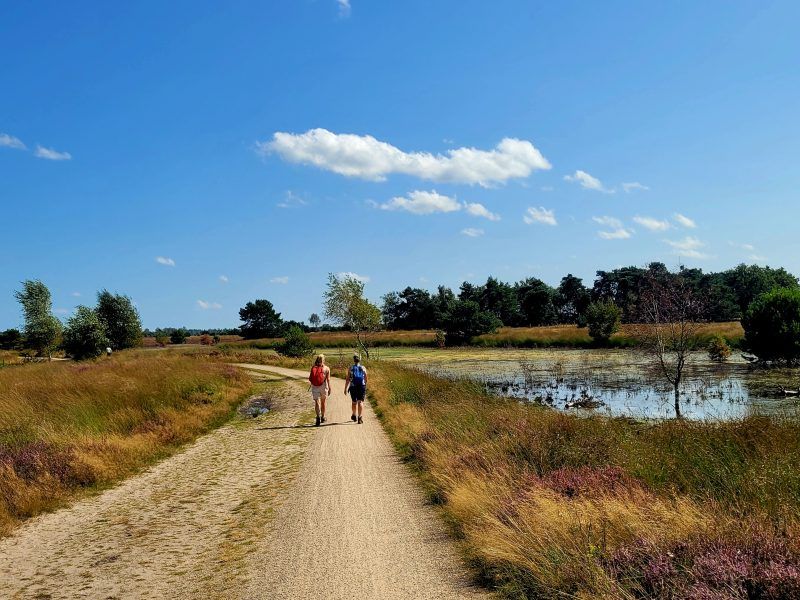
Would you like to stay updated on our walks and the latest news? Sign up for our monthly newsletter here.
Hiking injuries
Walking isn’t typically a sport prone to injuries. However, it’s possible to sustain an injury while hiking. What are the most common hiking injuries? And what should you do if you experience one? We’ve compiled our tips for you.
The most common hiking injuries and ailments are:
1. Blisters
2. Muscle pain
3. Heat and dehydration
4. Sudden fatigue (bonking)
5. Sore feet
6. Swollen fingers
7. Salt deficiency
8. Headache
9. Red spots on the lower legs
10. Shoulder pain
11. Sore knees
12. Leg cramps
13. Overworked Achilles tendon
14. Fatigue
15. Skin rash
16. Sprained ankle
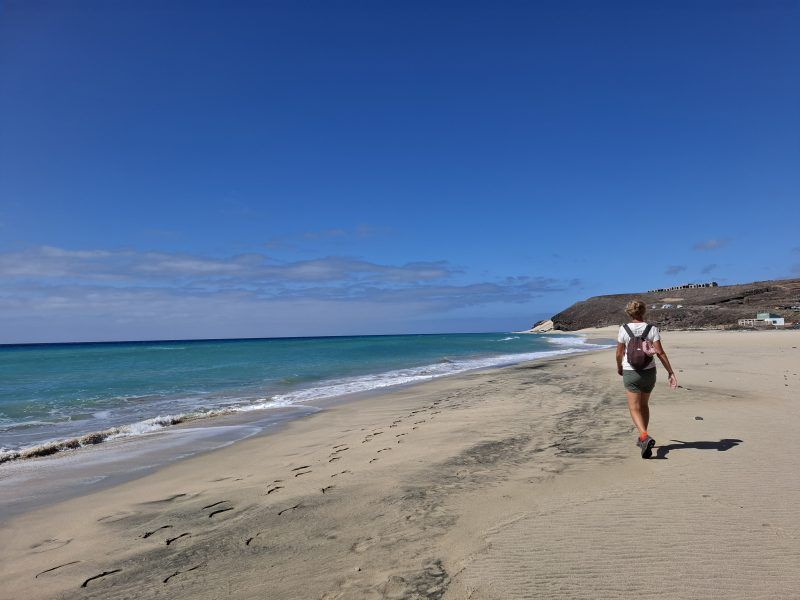
1. Blisters
Among all hiking injuries, blisters are the most common. The standard advice is to avoid popping them as long as possible. However, in some cases, carefully popping a blister can greatly relieve pain.
When to pop a blister
- If you decide to pop a blister, start by washing your feet. Use a clean needle or blister lance and puncture the blister at the side. Pierce in the direction of your step, so any remaining fluid naturally drains out as you walk. You may also heat the needle beforehand (use the blue part of the flame to avoid soot). Be careful to only pierce the outer skin layer, not the underlying skin, to prevent bleeding.
- Press the fluid out of the blister using a clean handkerchief or sterile gauze. Some hikers prefer to remove the entire skin, but this is risky due to potential infections.
- Cover the blister with a broad leukoplast or sports tape, overlapping the edges like shingles. Do not use regular bandages! This layer acts as a second skin and helps protect the blister.
When not to pop a blister
- Instead of popping the blister, you can simply leave it alone and cover it. Compeed, an oval-shaped blister plaster, is a popular option. Once applied correctly, you can continue walking for days or even a week until the blister disappears and new skin forms underneath.
- However, opinions on Compeed are mixed. Besides being relatively expensive, it can stick to your hiking socks, sometimes ruining them. A simple remedy is to apply an extra layer of leukoplast or sports tape over the Compeed. Also, sometimes the blister underneath Compeed doesn’t go away and may even get bigger. Never use Compeed on blisters that have already been popped, as removing it later can cause severe pain.
- You can also apply zinc ointment, which helps the blister dry out faster, making walking less painful the next day.
- Poorly fitting hiking boots or improper blister treatment can lead to blood blisters, which are often very painful. Treat a blood blister the same way as a regular blister.
- Sometimes, blisters form under calluses, making them hard to reach. Soaking your foot in warm (not hot) water for 10-15 minutes can make it easier to pierce through the callus with a needle. Then, treat the blister as mentioned above.
Preventing blisters
Preventing foot blisters starts well before your hiking trip. Here are our tips:
- Regular walking: The only way your feet can get used to your shoes is by regular walking. Long distances aren’t necessary—in fact, overly intense training schedules can even cause blisters by not giving your feet enough time to recover. Consistency is more important than distance.
- Proper hiking boots: Your boots should provide adequate support and prevent your feet from sliding, a major cause of blisters. At the same time, your toes should have enough room to move. Material is also important; leather boots breathe better than synthetic ones, which is noticeable in warm weather. Synthetic boots are also less likely to mold to your feet.
- Buy seamless hiking socks: Seamless socks reduce friction, a major cause of blisters.
- Insoles: In some cases, insoles can relieve pressure on blister-prone areas. There are many types available. Don’t buy insoles randomly; get advice from a good outdoor store. Poor insoles can worsen the problem.
- Foot care for blister prevention: Starting four weeks before a long hike, apply special creams to your feet daily. Examples include camphor spirit, GehWohl, and GehFit. These make your skin tougher and less prone to blisters. Wash your feet with cold water and without soap to avoid softening the skin. Calluses are good, but too much can cause blisters; remove excess calluses gently, possibly with a pumice stone.
Tips during the hike
- Preventive Taping: Before a hike, tape sensitive areas with leukoplast or sports tape. Leukoplast is chPreventing foot blisters starts well before your hiking trip. Here are our tips:eaper and conforms more easily to the foot, but the adhesive can stick to your socks. Sports tape leaves fewer adhesive residues and offers more protection due to its stiffness, though it’s more expensive. Make sure there are no creases when taping—especially on toes—as these can cause blisters. If needed, use small scissors to cut slits in the tape. If the tape sticks to your socks, rub some talcum powder on it to make it smoother and less sticky.
- Some people use Second Skin or Compeed as preventive measures. I personally wouldn’t recommend this, as these products are mainly for treating existing blisters. While they can help in some cases, they can also make things worse.
- Instead of taping, you can treat your feet with various powders and ointments, such as:
- Gehwohl Foot Cream (available at drugstores)
- Vaseline or Udder Balm (makes the skin smoother but less soft by retaining moisture)
- Talcum Powder (reapply after a midday break if necessary, but don’t use too much as clumps can cause blisters).
What works best for you is a matter of trial and error.
During the hike
- During breaks, take off your shoes and socks to let excess moisture evaporate. You might also change your socks or turn them inside out. Even better, bring an extra pair of socks.
After the hike
Take off your shoes and socks immediately. If there’s a stream nearby, it’s refreshing to stand in the water with your feet. The cold water toughens the skin. Note: this is only to prevent blisters—if you already have them, soaking your feet can risk infection and make things worse.
2. Muscle pain
Muscle pain usually occurs during the first few days of a hiking trip. Your muscles need time to adjust to the increased exertion. This type of pain is typically caused by microscopic tears in the muscle fibers due to intense exercise. Tears? That might sound serious, but it’s actually a normal process that’s fundamental to physical training. As long as you don’t overexert yourself, the muscle pain should disappear within a few days.
It’s tempting to take complete rest when dealing with this kind of hiking injury, but light physical activity is actually better for recovery. Foam rolling can also be helpful. To prevent muscle pain, a proper warm-up before hiking works wonders. When the weather isn’t too warm, it’s advisable to wear long pants, especially if it’s raining, as this helps keep your muscles from getting cold.
If the muscle pain is worse in the morning but eases as you walk, it might be a sign of tendonitis. The temptation is to keep walking, but doing so can risk turning the inflammation into a chronic condition. The only solution for this type of hiking injury is rest.
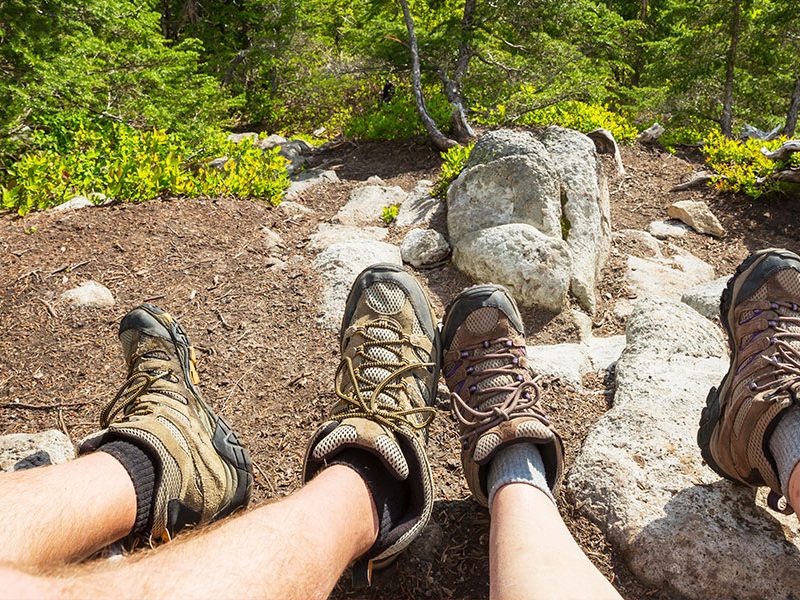
3. Heat and dehydration
When you start feeling the effects of heat, you might notice symptoms like sluggishness, reduced interest in your surroundings, thirst, and loss of appetite. But it can get worse: excessive sweating, muscle cramps, nausea, vomiting, confusion, chills, and fainting. Your body temperature can rise up to 40°C (104°F). These symptoms can occur even without direct sunlight. A more serious condition is heatstroke, which happens when the brain overheats, often due to direct sun exposure to the head. Body temperature can reach up to 42°C (107.6°F), and the person may experience seizures or lose consciousness. Without prompt treatment, heatstroke can be fatal.
Treating overheating
Overheating is usually temporary, as long as the person remains conscious and does not have a fever. Make sure they drink plenty of fluids and rest in the shade. Ideally, drink water with a bit of salt or Oral Rehydration Salts (ORS). If symptoms worsen and heatstroke is suspected, call an ambulance immediately. Until help arrives, try to cool the person down as much as possible. Offer small sips of water, as large amounts can induce vomiting.
Preventing overheating
The simplest, but highly effective, remedy against heat-related hiking injuries might sound obvious: avoid walking or cycling in extreme heat. Up to around 25°C (77°F), outdoor enthusiasts are unlikely to suffer from heat, but above that, especially with high humidity, you need to seriously consider whether it’s safe to continue. If you’re planning a hiking or cycling trip, take the time to research the expected temperatures.
Practical tips
If you decide to hike in these conditions, take the following precautions:
- Stay Hydrated: Don’t wait until you’re thirsty to drink. Most people feel thirsty only after losing more than a liter of fluid, by which point physical performance has already declined.
- Monitor Your Urine: If you’re urinating less frequently or your urine is darker than usual, you may be dehydrated.
- Avoid Beer and Caffeine: Although they might seem refreshing or stimulating, these are diuretics that will make you more dehydrated in the long run.
- Maintain Salt Levels: Carry something salty, like salted licorice, ORS, or a bit of dextrose with a pinch of salt in your water bottle.
- Clothing: Cover as much skin as possible. Wear a hat, long sleeves (a lightweight shirt), and long pants (lightweight, not jeans).
- Timing: Walk or cycle in the early morning or late evening when the sun is less intense.
- Pace Yourself: Move slowly, especially when climbing, and take frequent breaks, even if you feel strong.
- Know Your Limits: Perhaps the most important advice for avoiding heat-related hiking injuries is to know your limits. Listen to your body and don’t push yourself in extreme heat. Be prepared to shorten or abandon your hike at the first signs of overheating. Experienced outdoor enthusiasts often push through discomfort, but sometimes it’s crucial to recognize when persevering poses too great a risk.
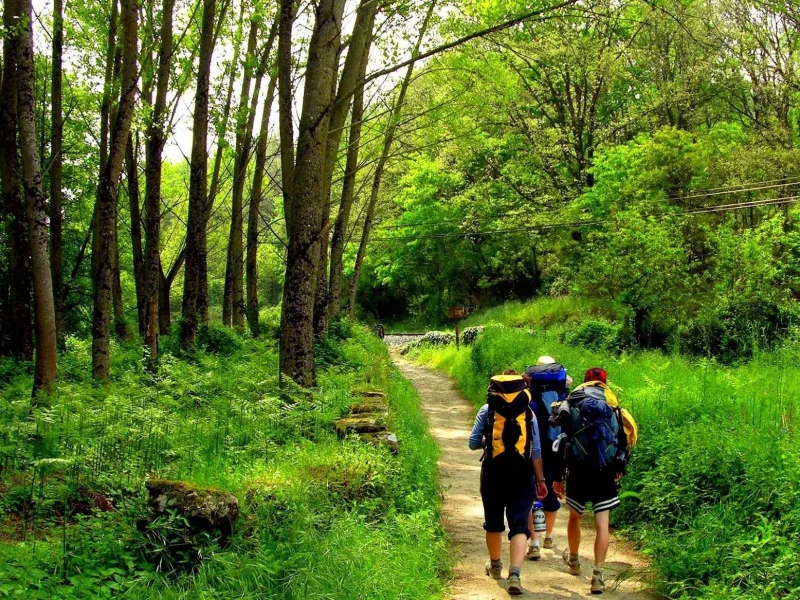
4. Hitting the wall
During physical exertion, such as hiking, your body uses up energy. It first draws on your glucose (blood sugar) reserves, then glycogen stores. When you hit the wall, also known as “bonking,” you’ve exhausted your glucose and glycogen reserves. Your blood sugar is low, and you feel weak, fatigued, and unable to continue.
What to do if you hit the wall
When you hit the wall, the key is to replenish your body’s glucose as quickly as possible. Unfortunately, it takes time for your glucose levels to return to normal, so that weak feeling won’t disappear immediately. Eat something high in sugars and low in fiber as soon as possible. This will raise your glucose levels the quickest.
Fiber-rich foods digest too slowly. Suitable options during a “bonk” include energy bars, energy gels, white bread with jam or syrup, dextrose, sports drinks, or gummies. If you’re planning a long hike, always carry a sugary snack for emergencies. You might also find something to eat along the way, but that depends on whether there’s a store or café nearby. During a “bonk,” even half a kilometer can feel like a marathon.
Don’t suddenly eat a large amount of carbohydrates, as your stomach can only process 60 to 80 grams of carbs per hour. Consuming more can lead to stomach issues, putting you in an even worse situation. Take a break to allow your body to absorb the sugars properly. Sit down somewhere and regain your strength. Often, you’ll feel a bit better after eating.
Once you regain some energy, continue your hike, but adjust your pace according to how you feel. Even if you have to slow down, you’ll at least reach your destination.
5. Sore feet
A well-fitting, comfortable hiking shoe is essential for an enjoyable hiking experience. While most hiking shoes provide comfort, they often lack support under the foot, where it’s most needed. Many problems arise from foot arch collapse. About 80% of people experience this, where the foot lengthens with each step, causing friction.
This friction occurs in different areas for everyone, such as the ball of the foot, midfoot, heel, or toes. Issues caused by friction or arch collapse include blisters, calluses, or a burning sensation under the foot. Heel spurs also result from excessive arch collapse, typically causing pain when starting to walk. If the pain is localized, an ill-fitting insole may be the cause. If the entire bottom of your foot hurts, it might be due to walking too long or carrying a heavy backpack.
If you experience pain and swelling in the midfoot, it could be a stress fracture, caused by excessive walking. Pain in the tips of your toes indicates the need for larger socks or shoes! Many hikers buy shoes at least one size larger than their usual size.
6. Swollen fingers
Many hikers experience swollen, stiff fingers after some time. While this isn’t a dangerous hiking injury, it’s likely due to gravity. When hiking, your hands are usually hanging down. Meanwhile, your heart rate increases, and blood flows faster through your body. Blood pools in your fingers, causing them to swell a bit. If this bothers you, here are a few tips:
- Carry two sticks or other objects to hold in your hands, squeezing them occasionally.
- Move your fingers regularly, make fists, or hold your hands above your head for a few seconds.
- Remove your rings while hiking, as they can cause slight constriction.
- Most backpacks have loops on the front of the shoulder straps. You can hook your thumbs in them occasionally to keep your hands raised instead of hanging down.
- From personal experience, I’ve found that wearing hiking gloves reduces this issue.
7. Salt deficiency
This type of hiking injury is more common during strenuous multi-day treks in hot weather. It manifests as weak legs and overall fatigue. Salt deficiency is easy to fix by eating salted licorice or drinking a cup of broth, but the effects usually aren’t noticeable until the next day. Besides salted licorice and broth, electrolyte drinks containing potassium and magnesium can be effective. ORS (Oral Rehydration Salts) is another good option for quick rehydration. If your legs remain weak despite these measures, you may be overexerted. The remedy: take longer rest breaks, slow down your pace, and eat well.
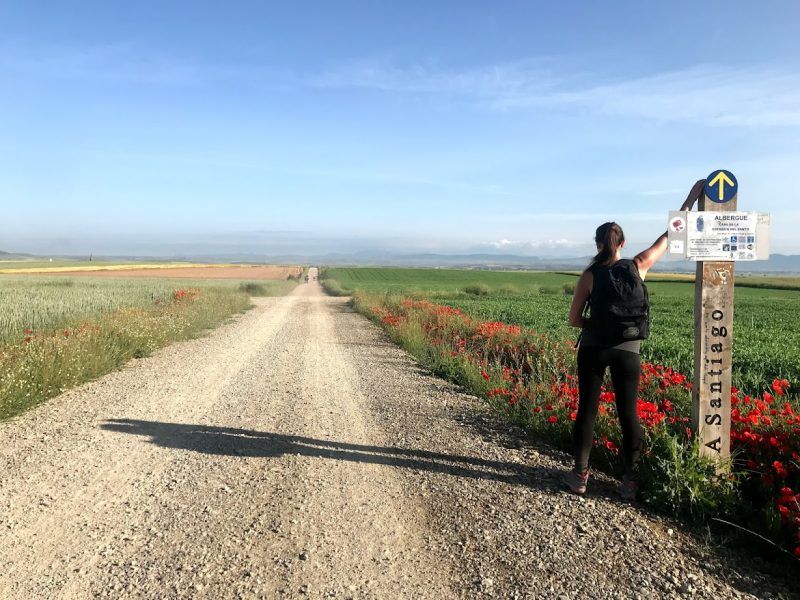
8. Headaches
Headaches during a hike can have various causes:
- Hangover from excessive alcohol consumption.
- Too much coffee during the hike.
- Prolonged exposure to the sun.
- Dehydration (you need to drink much more on a hiking trip than in daily life).
- Sleeping too warm or for too long.
- Stress.
Stress might seem odd—after all, hiking isn’t that intense, right? However, it’s not uncommon for hikers with stressful jobs, excessive coffee intake, and insufficient sleep to finally “hit the wall” during a peaceful hike.
9. Red spots on lower legs
A possible cause is ‘pressure urticaria.’ This is an itchy allergic reaction caused by pressure on blood vessels, for example, from tight socks, overly tight shoes, or even the straps of a shoulder bag or backpack. The solution: take preventive medication, such as an antihistamine and anti-inflammatory, and wear only well-worn socks that don’t compress too much, or opt for compression socks as they distribute pressure more evenly compared to regular hiking socks.
Your skin may also react to the heat of the asphalt you’re walking on, known as ‘asphalt legs.’ This causes large, red, and sometimes painful spots on your lower legs. The heat from the asphalt essentially burns through your skin; the solution is to walk less on asphalt and better protect yourself against the heat—wearing long, ventilated cotton pants instead of shorts and avoiding tight socks and shoes.
Another possibility is an allergic reaction to the material of your socks or shoes. Recent research also suggests the possibility of ‘exercise-induced vasculitis,’ a vascular inflammation that can occur during exertion, particularly in hikers. The solution: avoid tight clothing and ensure proper hydration, a great way to protect yourself from this hiking injury.
10. Shoulder pain
Often, the cause of this hiking injury is an incorrectly adjusted backpack. A general rule is that if you can’t fit your hand between your shoulders and the shoulder strap, your backpack is set too low and is hanging too much on your shoulders. Additionally, a well-adjusted hip belt is crucial. It helps transfer weight from your shoulders to your hips. Besides adjusting your backpack properly, you might consider doing back and shoulder-strengthening exercises.
Another possible cause is sleeping on your side on a thin sleeping mat. In addition to adjusting your backpack and mat, consider doing back and shoulder-strengthening exercises.
11. Sore knees
This is one of the most insidious hiking injuries: the pain builds up slowly, but by the time it becomes a problem, it’s too late, and you’re likely stuck with it for the rest of your hiking trip. The causes are diverse: an overly heavy backpack, a stiff walking style, poor footwear, worn-out soles, poor insoles, or simply weak knees.
Knee pain often first appears during steep descents in the mountains, especially when hiking in a group. There are always a few athletic types who speed down the trail during every hike. Fearing you might fall behind, it’s tempting to pick up your pace as well. For hikers with weak knees, I recommend using hiking poles. They provide stability while walking and relieve pressure on the knees. When descending, set the poles 10 cm longer than when ascending for optimal support.
12. Leg cramps
Leg cramps during a hike are among the hiking injuries that are usually due to overexertion: the hike is too long, it’s too hot, or the elevation changes are too significant. Leg cramps can also occur at night, not just during hiking trips. The most common cause is relative dehydration—meaning you haven’t drunk enough. Sometimes, it’s due to magnesium deficiency caused by medication or alcohol use.
- Excessive fluid loss is another factor. Hiking in warm, sunny weather often leads to fluid loss (heavy sweating due to the sun and heat combined with insufficient drinking), so cramps are often classified as a heat-related condition. Sodium deficiency (salt deficiency) can also cause leg cramps.
- Sodium plays a crucial role in muscle contraction. When your body lacks sodium, involuntary muscle contractions (cramps) can occur.
- High muscle tension and muscle fatigue are other contributing factors.
What to do to avoid this hiking injury?
1. Gently shake the cramped muscle and massage it softly.
2. If that doesn’t help, try contracting the muscle opposite the cramped one. For example, if you have a cramp in your calf muscle (back of the lower leg), tighten the muscles at the front of your lower leg by moving your toes toward your nose.
3. If that still doesn’t work, gently stretch the cramped muscle. Do not bounce; this can cause the muscle to tear!
How to prevent leg cramps?
1. Drink plenty of water.
2. Ensure you consume enough salt.
3. Stretch your muscles before, during, and after your hike to prevent muscle shortening.
4. Train adequately before your hike.
13. Overloaded Achilles tendon
Similar to sore knees, this is a sneaky hiking injury: by the time you start feeling it, it’s often too late. Moreover, painful Achilles tendons take a long time to heal—often several months to a year. The causes are usually an overly heavy backpack, insufficient hiking training, a too-fast hiking pace (especially uphill), and too few rest breaks. While your tendons aren’t too painful yet, it’s tempting to keep going on your vacation.
Be aware that doing so significantly slows the healing process.
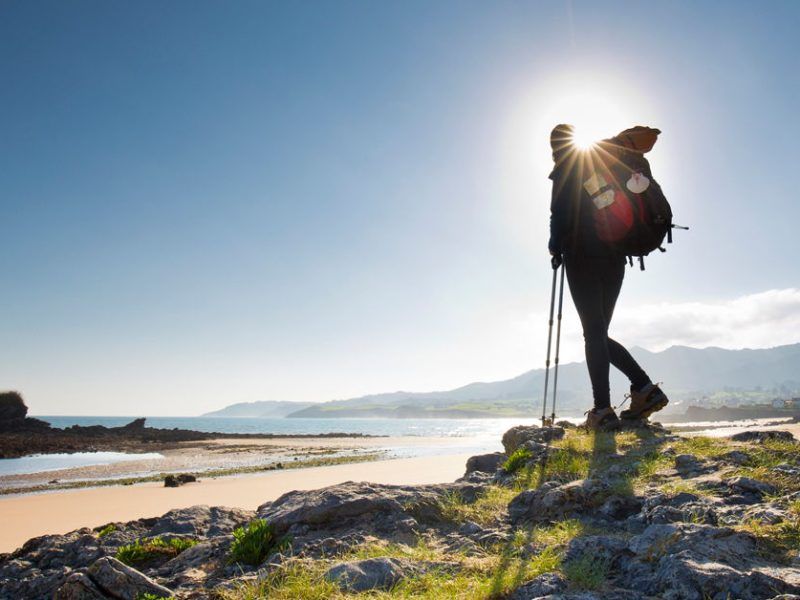
14. Fatigue
Overexertion is something that group members usually notice before the affected person does. It often begins with a reduced sense of humor, apathy, and less interest in the surroundings. When someone starts complaining more frequently after a few days, can’t get out of bed in the morning, and walks increasingly slower, the likely cause becomes clear: the vacation is simply too demanding for them. A rest day can work wonders, but on organized hiking tours with a strict schedule, this is often not possible.
Stop or Continue? Performance-driven individuals may want to push through to the bitter end, while those who prefer to enjoy life might want to spend the rest of their vacation in a different way than wearing hiking boots. The choice also depends on the rest of the group: Is the team spirit strong enough that fellow travelers are willing to support you, or are they not too upset if you drop out? Additionally, could your fatigue potentially endanger others? It all depends on the group and the hike. Sometimes, you can pull each other through tough times.
15. Skin rash
A bothersome condition that can develop during hikes is a skin rash in warm, moist areas: between the toes, in the groin, under the breasts, and in skin folds like armpits and belly folds. Itching, redness, and irritation can make your hike less enjoyable and increase the risk of skin infections. To prevent this, wear cotton and loose-fitting clothing rather than Lycra, which generates more heat and fits tightly.
Keep your skin clean and dry. If you’re prone to skin rashes, you can protect your skin preventively with creams containing zinc, like Sudocrem or zinc ointment, which have a drying effect. If the rash lasts more than five days and becomes painful, red with a defined edge, a fungal infection may have developed. Use miconazole cream, clean and dry the area, and apply the cream thinly three times a day—applying it too thickly can cause further moisture buildup to avoid this hiking injury.
16. Sprained ankle
A sprain occurs when the ankle twists inward or outward. This usually happens to hikers wearing low shoes, but even high shoes can’t always prevent a misstep from causing a sprain. What to do: Rest, possibly use a bandage or elastic sock, and apply cold compresses or elevate the leg to reduce swelling. Usually, the pain and swelling decrease after 3-4 days, but it may take up to two weeks before you can walk normally again.
For a severe sprain, seek medical attention. The more swelling, the more serious the injury. It’s a myth that you can’t walk on a broken ankle! In milder cases and in remote areas, you can manage with a compression bandage or tape. However, the longer you walk on it, the longer the recovery will take, potentially up to a month.
If you’ve sprained your ankles often while hiking, you might think that buying hiking shoes with better ankle support is the solution, but this offers only false security! The most important thing is to do strengthening exercises. The simplest exercise: Stand on the affected leg and try to maintain balance to avoid such a hiking injury.
The same applies to wearing a brace; it also gives a false sense of security. So, work on strengthening exercises if you have ‘weak ankles,’ and also check whether your footbed is adequate—often an insole is needed.
Step Forward with Confidence: Your Path to Safer Hiking
As our journey through the common challenges of hiking concludes, it’s clear that the keys to a safe and enjoyable hike lie in preparation, awareness, and the right response to injuries. Judith van den Hoven’s expertise, drawn from both her medical background and extensive hiking experiences, offers a blueprint for hikers to follow, ensuring that the only traces left behind are footprints—not setbacks.
Remember, every hike offers a new lesson in resilience and adaptation. Whether it’s managing blisters with expert care, hydrating adequately to ward off fatigue, or pacing yourself to prevent muscle strain, the right practices and preparations can significantly enhance your hiking experience.
We encourage you to carry the knowledge gained here into every step of your hiking injuries. Stay informed, stay prepared, and above all, stay keen to embrace the beauty of the natural world with respect and caution. Happy trails, and may each hike bring you closer to both nature’s splendor and personal endurance.
Disclaimer
This guide is intended to give you an overview of possible hiking injuries, not to diagnose them. Always consult a doctor if in doubt. WAW.travel cannot be held responsible for the (treatment of) hiking injuries.
How can I prevent hiking injuries before a long trek?
Start training hikes weeks before your trip to condition muscles and joints. Wear your actual hiking boots to break them in, strengthen ankles with balance exercises, and stretch before and after walking. Regular conditioning and good footwear are your best defense.
Can altitude or weather changes worsen hiking injuries?
Yes. Cold weather can stiffen muscles and joints, increasing the risk of strains, while hot and humid conditions raise the likelihood of dehydration and heatstroke. At high altitudes, lower oxygen levels can delay healing and fatigue muscles faster.
Are compression socks good for hiking injuries?
Compression socks improve circulation, reduce leg swelling, and can help prevent shin pain or “red spots” on the lower legs. They’re particularly useful for long-distance hikes or recovery days, but they should not feel too tight or restrictive.



Comment (0)